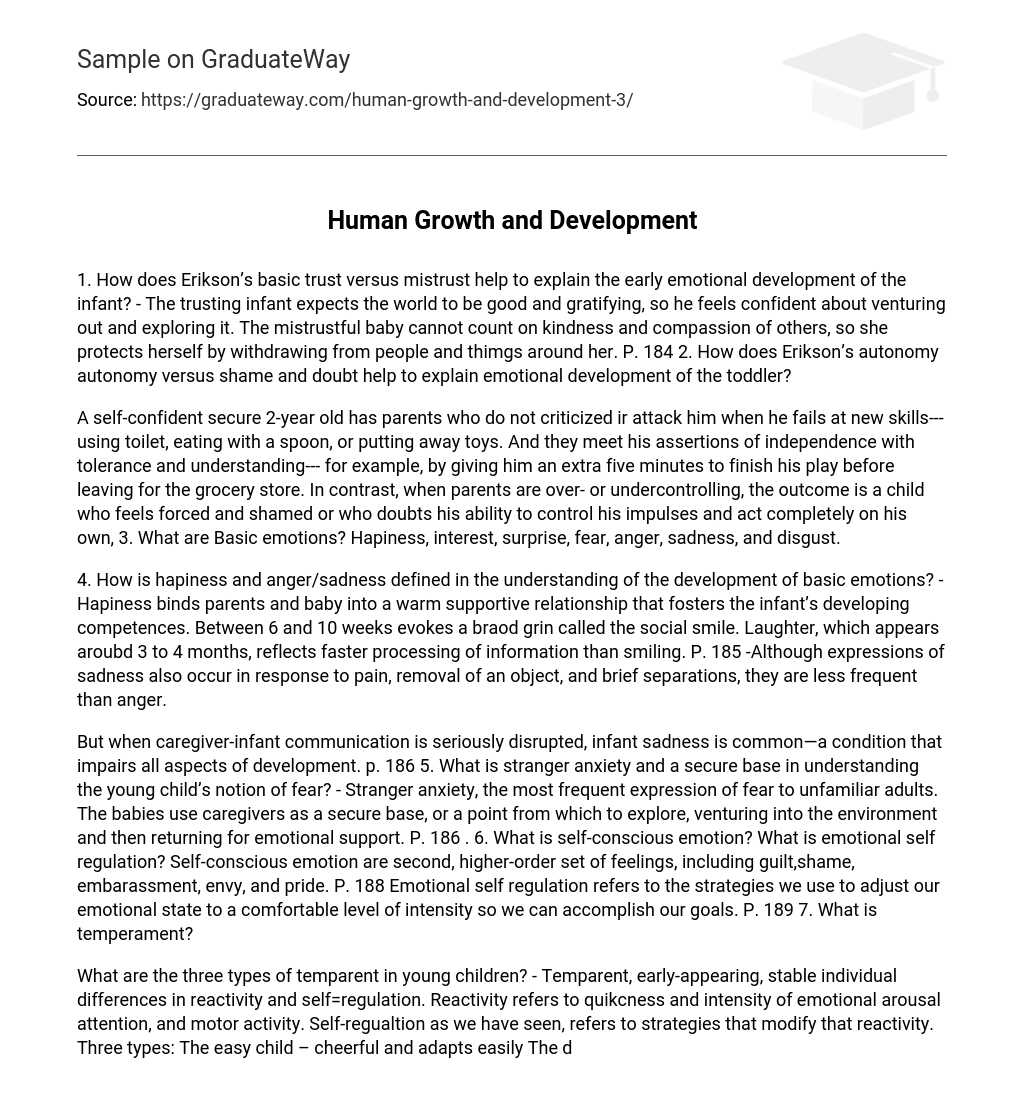1. How does Erikson’s basic trust versus mistrust help to explain the early emotional development of the infant? – The trusting infant expects the world to be good and gratifying, so he feels confident about venturing out and exploring it. The mistrustful baby cannot count on kindness and compassion of others, so she protects herself by withdrawing from people and thimgs around her. P. 184 2. How does Erikson’s autonomy autonomy versus shame and doubt help to explain emotional development of the toddler?
A self-confident secure 2-year old has parents who do not criticized ir attack him when he fails at new skills—using toilet, eating with a spoon, or putting away toys. And they meet his assertions of independence with tolerance and understanding— for example, by giving him an extra five minutes to finish his play before leaving for the grocery store. In contrast, when parents are over- or undercontrolling, the outcome is a child who feels forced and shamed or who doubts his ability to control his impulses and act completely on his own, 3. What are Basic emotions? Hapiness, interest, surprise, fear, anger, sadness, and disgust.
4. How is hapiness and anger/sadness defined in the understanding of the development of basic emotions? – Hapiness binds parents and baby into a warm supportive relationship that fosters the infant’s developing competences. Between 6 and 10 weeks evokes a braod grin called the social smile. Laughter, which appears aroubd 3 to 4 months, reflects faster processing of information than smiling. P. 185 -Although expressions of sadness also occur in response to pain, removal of an object, and brief separations, they are less frequent than anger.
But when caregiver-infant communication is seriously disrupted, infant sadness is common—a condition that impairs all aspects of development. p. 186 5. What is stranger anxiety and a secure base in understanding the young child’s notion of fear? – Stranger anxiety, the most frequent expression of fear to unfamiliar adults. The babies use caregivers as a secure base, or a point from which to explore, venturing into the environment and then returning for emotional support. P. 186 . 6. What is self-conscious emotion? What is emotional self regulation? Self-conscious emotion are second, higher-order set of feelings, including guilt,shame, embarassment, envy, and pride. P. 188 Emotional self regulation refers to the strategies we use to adjust our emotional state to a comfortable level of intensity so we can accomplish our goals. P. 189 7. What is temperament?
What are the three types of temparent in young children? – Temparent, early-appearing, stable individual differences in reactivity and self=regulation. Reactivity refers to quikcness and intensity of emotional arousal attention, and motor activity. Self-regualtion as we have seen, refers to strategies that modify that reactivity. Three types: The easy child – cheerful and adapts easily The difficult child – slow to adapt and reacts negatively and intensely The slow to warm up child – inactive, mild low key reactions, and in negative mood p. 190 8. How is temperament measured? – Through interviews or questionnaires to parents. Behavior rating by pediatricians, teachers, and others familiar with the child and laboratory observations by researchers has also been used. P 191 9. What is the goodness-of-fit model in child rearing? – To describe how temperament and environment together can produce favorable outcomes.
Goodness of fit involves creating child-rearing environments that recognize each child’s temperament while encouraging more adaptive functioning. P 194 10. What is attachment? What is the ethological theory of attachment? – Attachment is the strong affectionate tie we have with special people in our lives that leads us to feel pleasure when we interact with them and to be comforted by their nearness in times of stress. – Ethological theory of attachment – which recognizes the infant’s emotional tie to the caregiver as an evolved response that promotes survival, is the most widely accepted view.
P. 196 11. What are factors that affect attachment security? – Opportunity to establish a close relationship, quality of caregiving, the baby’s characteristics and family context. P. 200-202 12. What is self awareness? What is self-recognition? * Self-awareness – the sense of physically distinct of surroundings, as a separate being. P 206 * Self-recognition – identification of the self as a physically unique being . p 207 13. What is the categorical self and how do young children regard themselves? – categorical self is how they lassify themselves and others on the basis of age, sex, physical characteristics, and even goodness versus badness. P 208 14. What is self control? – the extent to which children can inhibit impulses, manage negative emotion, and behave in socially acceptable ways. P 208 What is empathy? – the ability to feel with another person. What is compliance – show clear awareness of caregivers’ wishes and expectations and can obey simple requests and commands. What is delay of gratification? – waiting for an appropriatetime and place ro engage in a tempting act.





